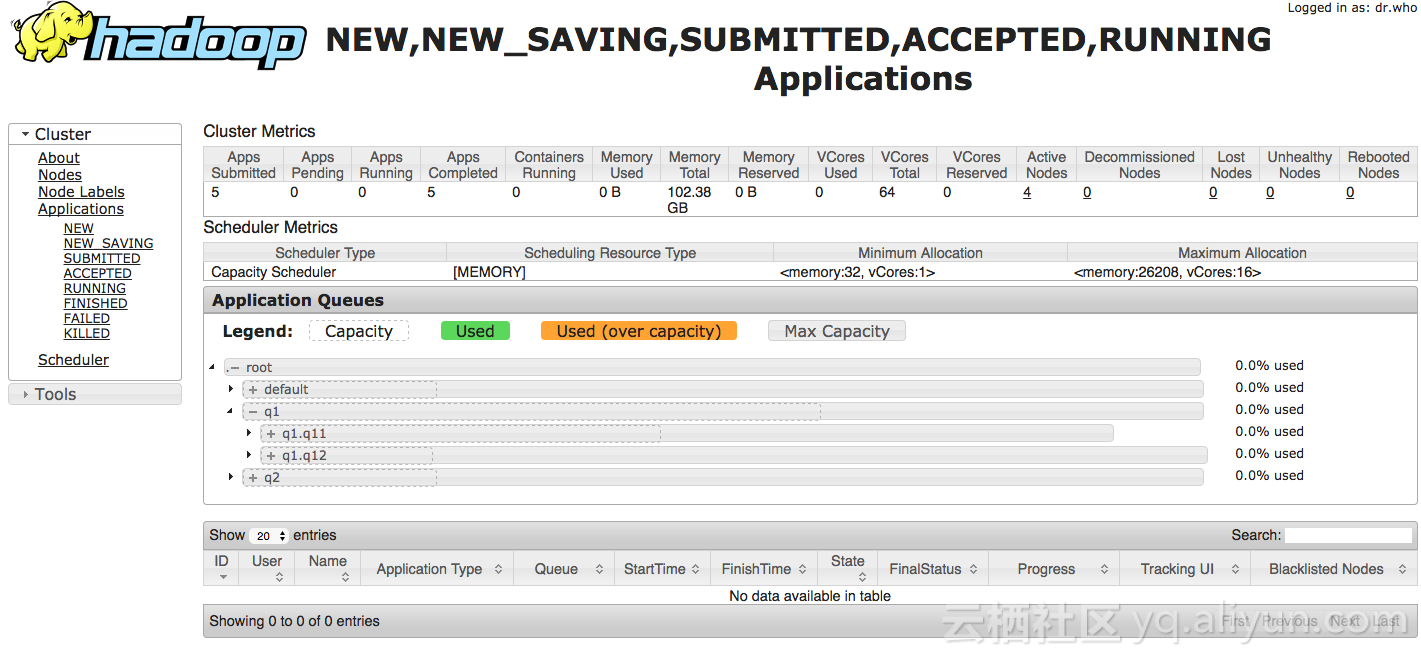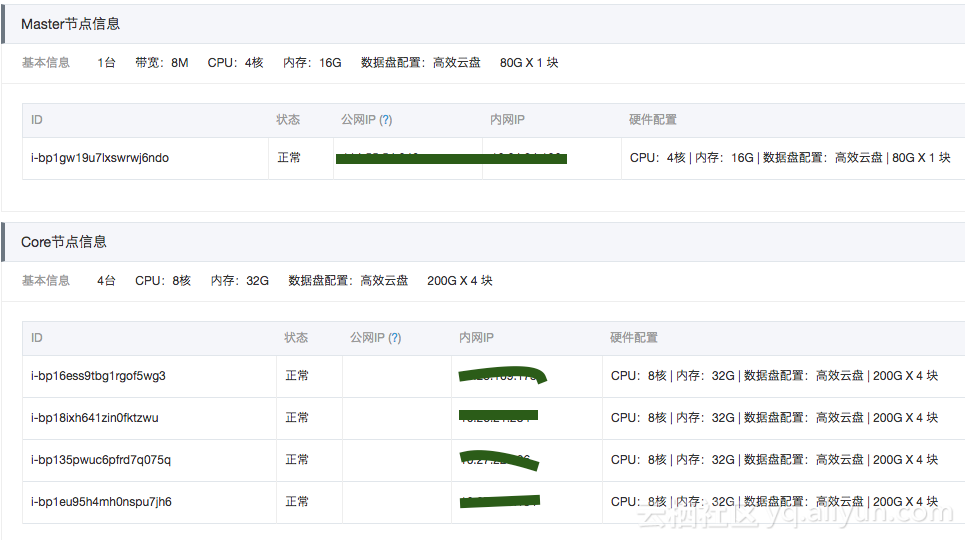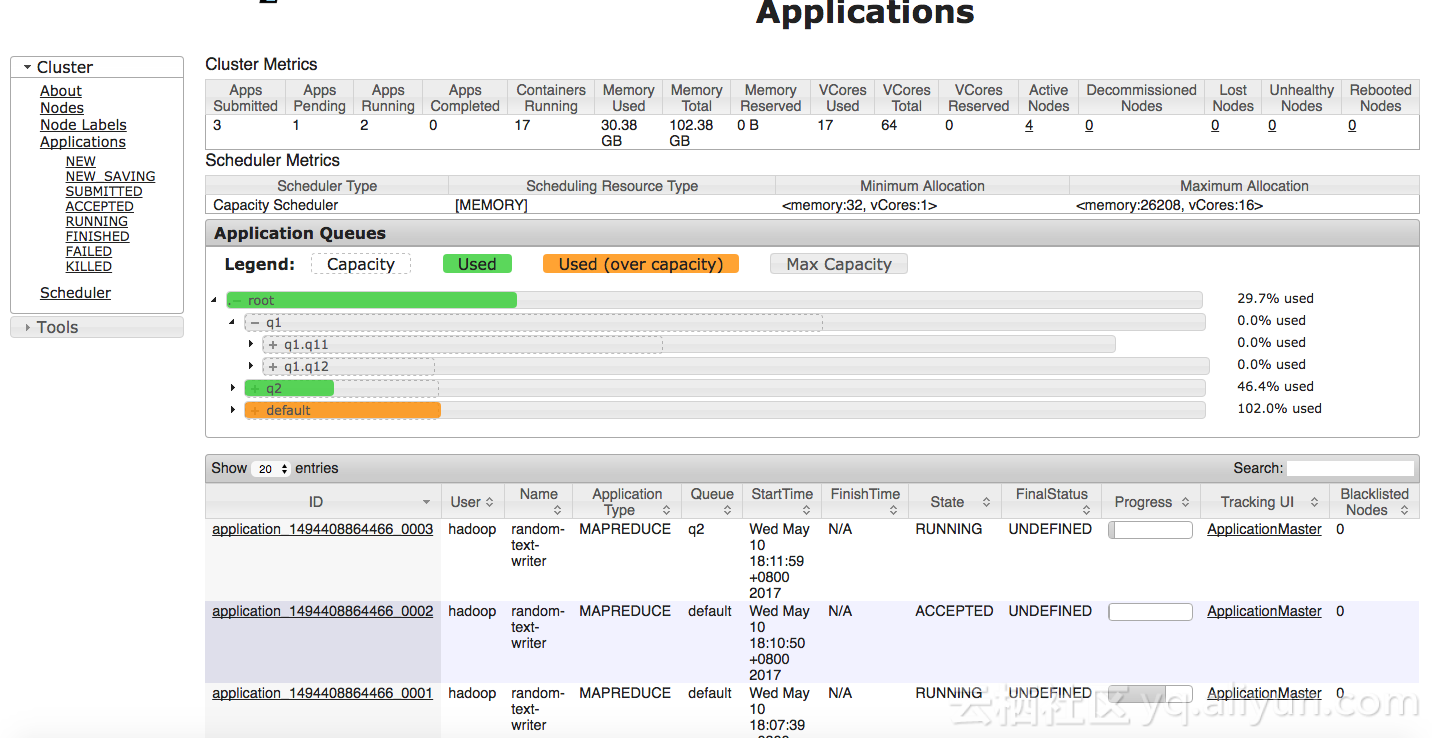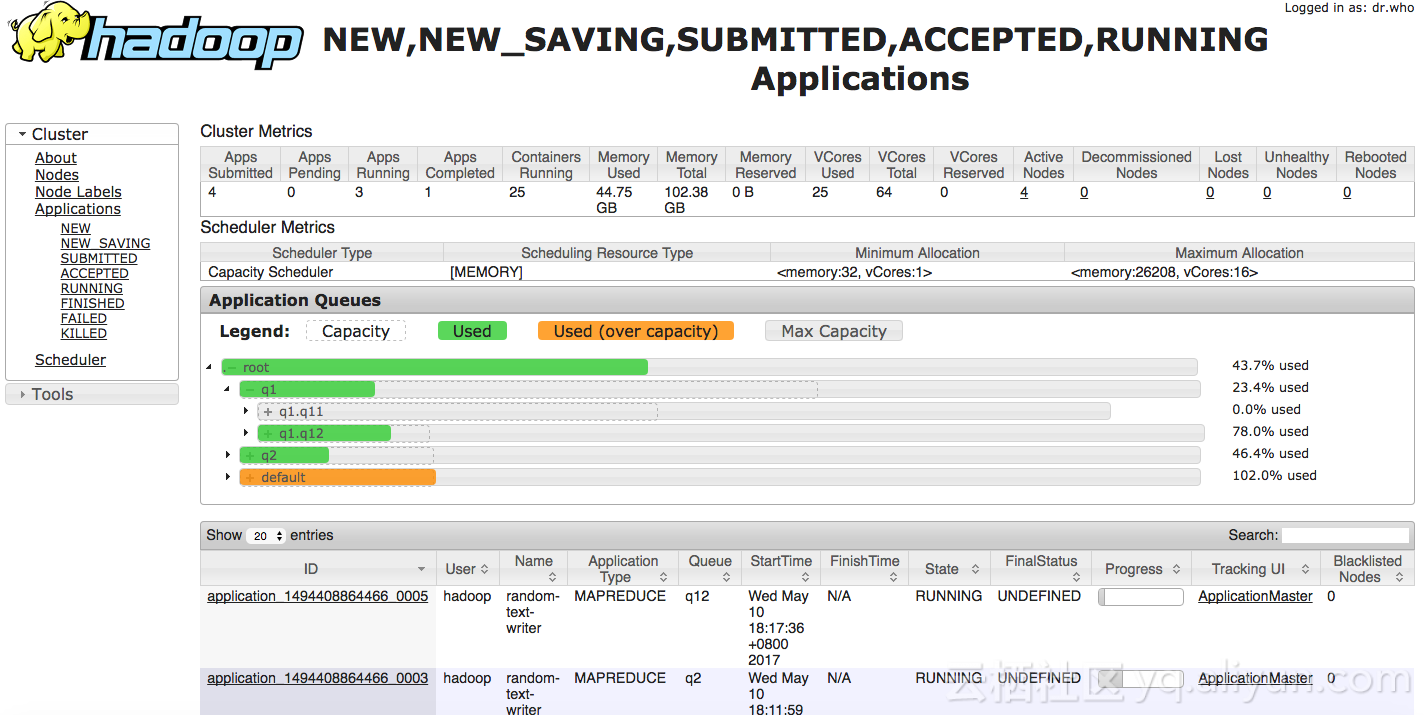利用yarn capacity scheduler在EMR集群上实现大集群的多租户的集群资源隔离和quota限制
转自:https://m.aliyun.com/yunqi/articles/79700
背景
使用过hadoop的人基本都会考虑集群里面资源的调度和优先级的问题,假设你现在所在的公司有一个大hadoop的集群,有很多不同的业务组同时使用。但是A项目组经常做一些定时的BI报表,B项目组则经常使用一些软件做一些临时需求。那么他们肯定会遇到同时提交任务的场景,这个时候到底如何分配资源满足这两个任务呢?是先执行A的任务,再执行B的任务,还是同时跑两个?
目前一些使用EMR的大公司,会使用一个比较大的集群,来共公司内部不同业务组的人共同使用,相对于使用多个小集群,使用大的集群一方面可以达到更高的最大性能,根据不同业务的峰谷情况来调度从而获得更高的资源利用里,降低总成本。另外一个方面,能够更好地在不同的业务组之间实现资源的共享和数据的流动。下面结合EMR集群,介绍一下如何进行大集群的资源quota管控。
yarn默认提供了两种调度规则,capacity scheduler和fair scheduler。现在使用比较多的是capacity scheduler。具体的实现原理和调度源码可以google一下capacity scheduler。
什么是capacity调度器
Capacity调度器说的通俗点,可以理解成一个个的资源队列。这个资源队列是用户自己去分配的。比如我大体上把整个集群分成了queue1queue2两个队列,queue1是给一个业务组使用queue2给另外一个业务组使用。如果第一个业务组下面又有两个方向,那么还可以继续分,比如专门做BI的和做实时分析的。那么队列的分配就可以参考下面的树形结构:
root
------default[20%]
------q1[60%]
|---q1.q11[70%]
|---q1.q12[30%]
------q2[20%]整个集群的queue必须挂在root下面。分成三个queue:default,q1和q2。三个队列使用集群资源的quota配比为:20%,60%,20%。default这个queue是必须要存在的。
虽然有了这样的资源分配,但是并不是说提交任务到q2里面,它就只能使用20%的资源,即使剩下的80%都空闲着。它也是能够实现(通过配置),只要资源实在空闲状态,那么q2就可以使用100%的资源。但是一旦其它队列提交了任务,q2就需要在释放资源后,把资源还给其它队列,直到达到预设de配比值。粗粒度上资源是按照上面的方式进行,在每个队列的内部,还是按照FIFO的原则来分配资源的。
capacity调度器特性
capacity调度器具有以下的几个特性:
- 层次化的队列设计,这种层次化的队列设计保证了子队列可以使用父队列设置的全部资源。这样通过层次化的管理,更容易合理分配和限制资源的使用。
容量保证,队列上都会设置一个资源的占比,这样可以保证每个队列都不会占用整个集群的资源。 - 安全,每个队列又严格的访问控制。用户只能向自己的队列里面提交任务,而且不能修改或者访问其他队列的任务。
- 弹性分配,空闲的资源可以被分配给任何队列。当多个队列出现争用的时候,则会按照比例进行平衡。
- 多租户租用,通过队列的容量限制,多个用户就可以共享同一个集群,同事保证每个队列分配到自己的容量,提高利用率。
- 操作性,yarn支持动态修改调整容量、权限等的分配,可以在运行时直接修改。还提供给管理员界面,来显示当前的队列状况。管理员可以在运行时,添加一个队列;但是不能删除一个队列。管理员还可以在运行时暂停某个队列,这样可以保证当前的队列在执行过程中,集群不会接收其他的任务。如果一个队列被设置成了stopped,那么就不能向他或者子队列上提交任务了。
capacity调度器的配置
登录EMR集群master节点,编辑配置文件:/etc/emr/hadoop-conf/capacity-scheduler.xml
这里先贴出来完整的比较复杂一点的配置,后面再详细说明:
<?xml version="1.0" encoding="utf-8"?>
<configuration>
<property>
<name>yarn.scheduler.capacity.maximum-applications</name>
<value>10000</value>
<description>Maximum number of applications that can be pending and running.</description>
</property>
<property>
<name>yarn.scheduler.capacity.maximum-am-resource-percent</name>
<value>0.25</value>
<description>Maximum percent of resources in the cluster which can be used to run application masters i.e. controls number of concurrent running applications.</description>
</property>
<property>
<name>yarn.scheduler.capacity.resource-calculator</name>
<value>org.apache.hadoop.yarn.util.resource.DefaultResourceCalculator</value>
<description>The ResourceCalculator implementation to be used to compare Resources in the scheduler. The default i.e. DefaultResourceCalculator only uses Memory while DominantResourceCalculator uses dominant-resource to compare multi-dimensional resources such as Memory, CPU etc.</description>
</property>
<property>
<name>yarn.scheduler.capacity.root.queues</name>
<value>default,q1,q2</value>
<description>The queues at the this level (root is the root queue).</description>
</property>
<property>
<name>yarn.scheduler.capacity.root.q1.queues</name>
<value>q11,q12</value>
<description>The queues at the this level (root is the root queue).</description>
</property>
<property>
<name>yarn.scheduler.capacity.root.default.capacity</name>
<value>20</value>
<description>Default queue target capacity.</description>
</property>
<property>
<name>yarn.scheduler.capacity.root.q1.capacity</name>
<value>60</value>
<description>Default queue target capacity.</description>
</property>
<property>
<name>yarn.scheduler.capacity.root.q2.capacity</name>
<value>20</value>
<description>Default queue target capacity.</description>
</property>
<property>
<name>yarn.scheduler.capacity.root.q1.q11.capacity</name>
<value>70</value>
<description>Default queue target capacity.</description>
</property>
<property>
<name>yarn.scheduler.capacity.root.q1.q11.maximum-capacity</name>
<value>90</value>
<description>Default queue target capacity.</description>
</property>
<property>
<name>yarn.scheduler.capacity.root.q1.q11.minimum-user-limit-percent</name>
<value>25</value>
<description>Default queue target capacity.</description>
</property>
<property>
<name>yarn.scheduler.capacity.root.q1.q12.capacity</name>
<value>30</value>
<description>Default queue target capacity.</description>
</property>
<property>
<name>yarn.scheduler.capacity.root.q1.q12.user-limit-factor</name>
<value>0.7</value>
<description>Default queue target capacity.</description>
</property>
<property>
<name>yarn.scheduler.capacity.root.q2.user-limit-factor</name>
<value>0.4</value>
<description>Default queue user limit a percentage from 0.0 to 1.0.</description>
</property>
<property>
<name>yarn.scheduler.capacity.root.q2.maximum-capacity</name>
<value>100</value>
<description>The maximum capacity of the default queue.</description>
</property>
<property>
<name>yarn.scheduler.capacity.root.q1.state</name>
<value>RUNNING</value>
<description>The state of the default queue. State can be one of RUNNING or STOPPED.</description>
</property>
<property>
<name>yarn.scheduler.capacity.root.q2.state</name>
<value>RUNNING</value>
<description>The state of the default queue. State can be one of RUNNING or STOPPED.</description>
</property>
<property>
<name>yarn.scheduler.capacity.root.q1.acl_submit_applications</name>
<value>*</value>
<description>The ACL of who can submit jobs to the default queue.</description>
</property>
<property>
<name>yarn.scheduler.capacity.root.q2.acl_submit_applications</name>
<value>*</value>
<description>The ACL of who can submit jobs to the default queue.</description>
</property>
<property>
<name>yarn.scheduler.capacity.root.q1.acl_administer_queue</name>
<value>*</value>
<description>The ACL of who can administer jobs on the default queue.</description>
</property>
<property>
<name>yarn.scheduler.capacity.root.q2.acl_administer_queue</name>
<value>*</value>
<description>The ACL of who can administer jobs on the default queue.</description>
</property>
<property>
<name>yarn.scheduler.capacity.node-locality-delay</name>
<value>40</value>
<description>Number of missed scheduling opportunities after which the CapacityScheduler attempts to schedule rack-local containers. Typically this should be set to number of nodes in the cluster, By default is setting approximately number of nodes in one rack which is 40.</description>
</property>
<property>
<name>yarn.scheduler.capacity.queue-mappings</name>
<value/>
<description>A list of mappings that will be used to assign jobs to queues The syntax for this list is [u|g]:[name]:[queue_name][,next mapping]* Typically this list will be used to map users to queues, for example, u:%user:%user maps all users to queues with the same name as the user.</description>
</property>
<property>
<name>yarn.scheduler.capacity.queue-mappings-override.enable</name>
<value>false</value>
<description>If a queue mapping is present, will it override the value specified by the user? This can be used by administrators to place jobs in queues that are different than the one specified by the user. The default is false.</description>
</property>
</configuration>在hadoop帐号下,执行命令刷新一下queue配置:/usr/lib/hadoop-current/bin/yarn rmadmin -refreshQueues
然后打开hadoop ui,就能看到效果:
参数说明
- 队列属性:
yarn.scheduler.capacity.${quere-path}.capacity - 例如下面的配置,表示共三个大的queue,default,q1,q2,q1下面又分了两个queue q11,q12。
<property>
<name>yarn.scheduler.capacity.root.queues</name>
<value>default,q1,q2</value>
<description>
The queues at the this level (root is the root queue).
</description>
</property>
<property>
<name>yarn.scheduler.capacity.root.q1.queues</name>
<value>q11,q12</value>
<description>
The queues at the this level (root is the root queue).
</description>
</property>- 下面的配置设置每个queue的资源quota配比:
<property>
<name>yarn.scheduler.capacity.root.default.capacity</name>
<value>20</value>
<description>Default queue target capacity.</description>
</property>
<property>
<name>yarn.scheduler.capacity.root.q1.capacity</name>
<value>60</value>
<description>Default queue target capacity.</description>
</property>
<property>
<name>yarn.scheduler.capacity.root.q2.capacity</name>
<value>20</value>
<description>Default queue target capacity.</description>
</property>- 设置q1大队列下面的两个小队列的资源quota配比:
<property>
<name>yarn.scheduler.capacity.root.q1.q11.capacity</name>
<value>70</value>
<description>Default queue target capacity.</description>
</property>
<property>
<name>yarn.scheduler.capacity.root.q1.q12.capacity</name>
<value>30</value>
<description>Default queue target capacity.</description>
</property>- 下面的配置表示,q1.q11这个queue,能够使用q1所有资源的最大比例,q1.q11分配的资源原本是占q1总资源的70%(见上面配置),但是如果q1里面没有其它作业在跑,都是空闲的,那么q11是可以使用到q1总资源的90%。但是如果q1里面没有这么多空闲资源,q11
只能使用到q1总资源的70%:
<property>
<name>yarn.scheduler.capacity.root.q1.q11.maximum-capacity</name>
<value>90</value>
<description>Default queue target capacity.</description>
</property>- 下面的配置表示q1.q11里面的作业的保底资源要有25%,意思是说,q1下面的总资源至少还要剩余25%,q11里面的作业才能提上来,如果q1下面的总资源已经小于25%了,那么往q11里面提作业就要等待:
<property>
<name>yarn.scheduler.capacity.root.q1.q11.minimum-user-limit-percent</name>
<value>25</value>
<description>Default queue target capacity.</description>
</property>另外一些比较重要的ACL配置:
- yarn.scheduler.capacity.root.q1.acl_submit_applications 表示哪些user/group可以往q1里面提作业;
- yarn.scheduler.capacity.queue-mappings 这个比较强大,可以设定user/group和queue的映射关系,格式为[u|g]:[name]:queue_name*
操作示例
本文使用的EMR集群配置:
- 注意,如果不指定queue,则默认往default提交:
hadoop jar /usr/lib/hadoop-current/share/hadoop/mapreduce/hadoop-mapreduce-examples-2.7.2.jar randomtextwriter -D mapreduce.randomtextwriter.totalbytes=100000000000 /HiBench/Wordcount/Input
- 如果指定一个不存在的queue,则会报错
hadoop jar /usr/lib/hadoop-current/share/hadoop/mapreduce/hadoop-mapreduce-examples-2.7.2.jar randomtextwriter -D mapreduce.randomtextwriter.totalbytes=100000000000 -D mapreduce.job.queuename=notExist /HiBench/Wordcount/Input3Caused by: org.apache.hadoop.yarn.exceptions.YarnException: Failed to submit application_1494398749894_0010 to YARN : Application application_1494398749894_0010 submitted by user hadoop to unknown queue: notExist- 再往default里面提交job,发现作业等待,因为default的20% quota已经用完。

- 然后往q2里面提交一个作业:
hadoop jar /usr/lib/hadoop-current/share/hadoop/mapreduce/hadoop-mapreduce-examples-2.7.2.jar randomtextwriter -D mapreduce.randomtextwriter.totalbytes=100000000000 -D mapreduce.job.queuename=q2 /HiBench/Wordcount/Input3
设置了q2单个作业不能超过q2总队列资源的40%,可以看到只用到50%多,尽管还有其它map在等待,也是不会占用更大资源。当然,这里不是非常精确,跟集群总体配置和每个map占用的资源有关,一个map占用的资源可以看成最小单元,一个map占用的资源不一定正好到达设定的比例,有可能会超过一点。
- 往q1.q12里面提交job
hadoop jar /usr/lib/hadoop-current/share/hadoop/mapreduce/hadoop-mapreduce-examples-2.7.2.jar randomtextwriter -D mapreduce.randomtextwriter.totalbytes=100000000000 -D mapreduce.job.queuename=q12 /HiBench/Wordcount/Input4
可以看到,q12也设置了yarn.scheduler.capacity.root.q1.q12.user-limit-factor为0.7,可以看到只占用了q12的78%。
- 往q11里面提交一个作业,会发现它直接占满了q11,是因为q11设置了yarn.scheduler.capacity.root.q1.q11.maximum-capacity为90%,即q11能占到q1总资源的90%。
hadoop jar /usr/lib/hadoop-current/share/hadoop/mapreduce/hadoop-mapreduce-examples-2.7.2.jar randomtextwriter -D mapreduce.randomtextwriter.totalbytes=100000000000 -D mapreduce.job.queuename=q11 /HiBench/Wordcount/Input5
通过上面的例子,可以看到yarn的capacity scheduler还是很强大的,可以实现对集群资源的控制和优先级调度。以上例子中使用了hadoop作业,指定queue的参数为-D mapreduce.job.queuename=${queue-name},如果是spark作业,可以用--queue ${queue-name}指定。以上作业的提交方式可以直接在EMR控制台的作业中设置。
利用yarn capacity scheduler在EMR集群上实现大集群的多租户的集群资源隔离和quota限制的更多相关文章
- <Yarn> <Capacity Scheduler> <Source Code>
Yarn capacity scheduler 首先要知道, [Attention: RM有两个组件,其中Scheduler完全就只是负责资源的分配:ApplicationsManager则负责接受a ...
- Hadoop Yarn Capacity Scheduler
Capacity 调度器配置 <property> <name>yarn.resourcemanager.scheduler.class<name> <val ...
- hadoop 把mapreduce任务从本地提交到hadoop集群上运行
MapReduce任务有三种运行方式: 1.windows(linux)本地调试运行,需要本地hadoop环境支持 2.本地编译成jar包,手动发送到hadoop集群上用hadoop jar或者yar ...
- Hadoop的三种调度器FIFO、Capacity Scheduler、Fair Scheduler(转载)
目前Hadoop有三种比较流行的资源调度器:FIFO .Capacity Scheduler.Fair Scheduler.目前Hadoop2.7默认使用的是Capacity Scheduler容量调 ...
- Hadoop Yarn内存资源隔离实现原理——基于线程监控的内存隔离方案
注:本文以hadoop-2.5.0-cdh5.3.2为例进行说明. Hadoop Yarn的资源隔离是指为运行着不同任务的“Container”提供可独立使用的计算资源,以避免它们之间相互干扰.目 ...
- YARN资源调度策略之Capacity Scheduler
背景 yarn默认使用的是最简单的FIFO调度器,即一个default队列,所有用户共享,分配资源也是先到先得,没有优先级之分.有时一两个任务就把资源全占了,其他任务吃不到资源造成饥饿,显然这样的资源 ...
- YARN的Fair Scheduler和Capacity Scheduler
关于Scheduler YARN有四种调度机制:Fair Schedule,Capacity Schedule,FIFO以及Priority: 其中Fair Scheduler是资源池机制,进入到里面 ...
- 012 Spark在IDEA中打jar包,并在集群上运行(包括local模式,standalone模式,yarn模式的集群运行)
一:打包成jar 1.修改代码 2.使用maven打包 但是目录中有中文,会出现打包错误 3.第二种方式 4.下一步 5.下一步 6.下一步 7.下一步 8.下一步 9.完成 二:在集群上运行(loc ...
- 有关python numpy pandas scipy 等 能在YARN集群上 运行PySpark
有关这个问题,似乎这个在某些时候,用python写好,且spark没有响应的算法支持, 能否能在YARN集群上 运行PySpark方式, 将python分析程序提交上去? Spark Applicat ...
随机推荐
- mongoDB 文档概念
mongoDB 文档概念 什么是文档 文档是 mongodb 基本的数据组织单元,类似于mysql 中的记录 文档由多个键值对组成,每个键值对表达一个数据项 属于 bson 数据 ps: bson ...
- re 模块 分组特别说明
关于分组优先以及 " | " 的细致练习 from django.test import TestCase import re # Create your tests here. ...
- 20165223 《信息安全系统设计基础》 实现mypwd
一.学习pwd命令 1. pwd命令简介 英文原名:Print Working Directory 指令功能:打印出当前工作目录 执行权限:All User 指令所在路径:/usr/bin/pwd 或 ...
- Numpy系列(一)- array
初始Numpy 一.什么是Numpy? 简单来说,Numpy 是 Python 的一个科学计算包,包含了多维数组以及多维数组的操作. Numpy 的核心是 ndarray 对象,这个对象封装了同质数据 ...
- 爬虫解析之css,xpath语法
一.xpath语法 xpath实例文档 <?xml version="1.0" encoding="ISO-8859-1"?> <bookst ...
- org.hibernate.ObjectNotFoundException: No row with the given identifier exists解决办法
hibernate-取消关联外键引用数据丢失抛异常的设置@NotFound hibernate项目里面配了很多many-to-one的关联,后台在查询数据时已经作了健全性判断,但还是经常抛出对象找不到 ...
- Entity Framework入门教程(15)---DbContext追踪实体状态改变
这一节介绍DbContext追踪实体的变化.EF支持DbContext在其生命周期中自动追踪加载的实体.我们可以通过DbChangeTracker类获取DbContext追踪的所有实体的变化. 注意每 ...
- [物理学与PDEs]第1章第4节 电磁能量和电磁动量, 能量、动量守恒与转化定律 4.3 电磁能量 (动量) 密度, 电磁能量流 (动量流) 密度
1. 电磁能量密度: $\cfrac{1}{2}\sex{\ve_0E^2+\cfrac{1}{\mu_0}B^2}$. 2. 电磁能量流密度向量: ${\bf S}=\cfrac{1}{\mu_0} ...
- 应用留数定理计算实积分 $\dps{I(x)=\int_{-1}^1\frac{\rd t}{\sqrt{1-t^2}(t-x)}\ (|x|>1,x\in\bbR)}$ [华中师范大学2010年复变函数复试试题]
应用留数定理计算实积分 $\dps{I(x)=\int_{-1}^1\frac{\rd t}{\sqrt{1-t^2}(t-x)}\ (|x|>1,x\in\bbR)}$ [华中师范大学2010 ...
- webpack学习笔记——sourcemap(使用webpack打包的项目如何调试代码)
[webpack]devtool里的7种SourceMap模式是什么鬼? 里面详细介绍了7种模式的区别,和建议使用. webpack sourcemap 选项多种模式的一些解释 两篇文章大同小异,第一 ...
